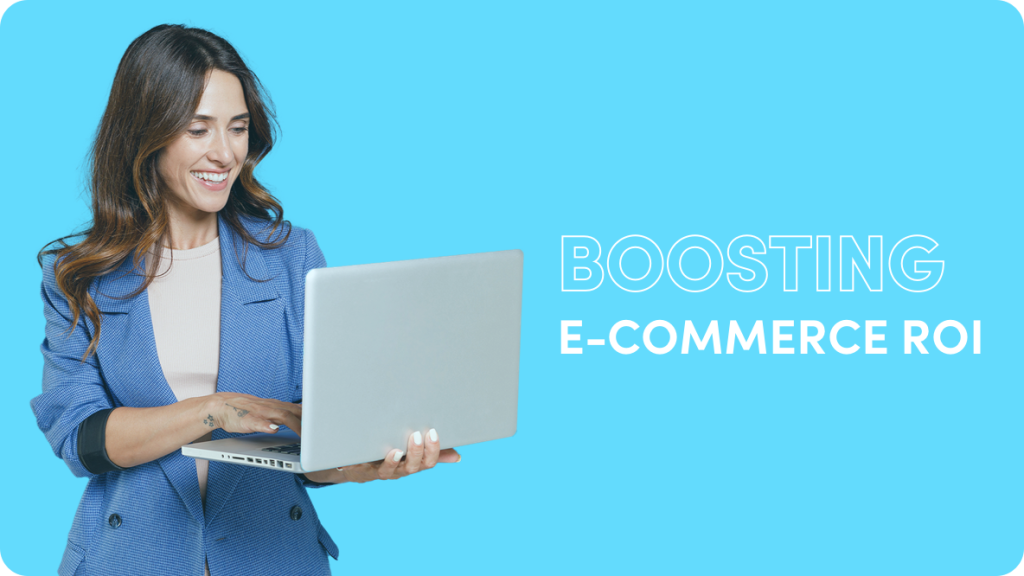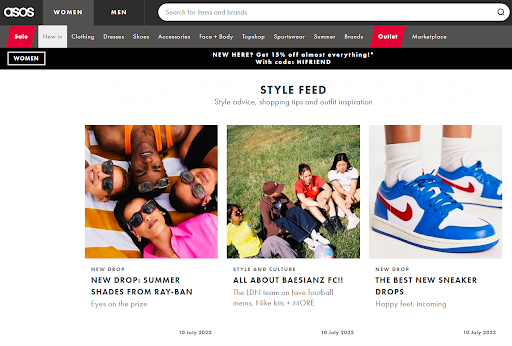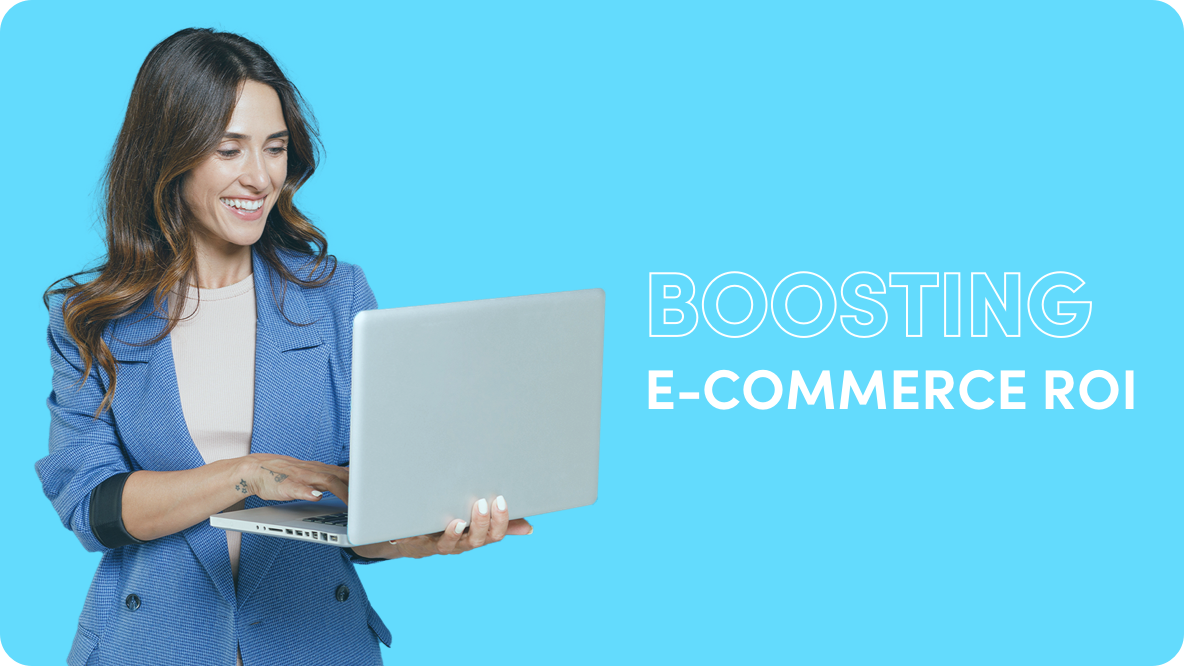Strategies for Boosting E-Commerce ROI: A Comprehensive Guide

Which company springs to mind first when you think of e-commerce?
It’s hard not to think of Amazon, right? They’re the e-commerce giants, after all.
But there must have been a moment when Jeff Bezos, in the early days, asked the all-important question – how can we increase our ROI?
From this, Amazon sparked a revolution with their ROI-boosting strategy – recommendation algorithms.
In fact, it is reported that Amazon generates a staggering 35% of its revenue from its recommendation engine. This is just one example of how strategic changes can lead to significant breakthroughs.
But don’t worry, you don’t have to be ‘Amazon’ to get this kind of success. Whether you’re a small startup or established e-commerce business, you can apply a diverse range of strategies to move the ROI needle.
In this comprehensive guide, we’ll look at strategies for boosting e-commerce ROI, how to measure success, and guide you on scaling up your efforts to reach new heights.
Understanding E-Commerce ROI
What is e-commerce ROI?
Every e-commerce business must keep a close eye on return on investment (ROI) if they want to be successful. For instance, for every dollar you spend on marketing and advertising, you should aim to make more than one dollar in return, which is known as a positive ROI. Anything over 100% ROI is a positive return, anything below 100% is a loss.
Think of ROI as a litmus test. You use it to measure the success of your marketing efforts. You put money into your marketing and advertising with the intention of making a profit. The higher your ROI, the wider your profit margin.
Let’s take a look at an example outside of the e-commerce world. Imagine that you run a bakery selling cupcakes. You spend $100 on packaging, shop window display, and even ads in the local paper. By the end of the day, you’ve sold cupcakes worth $500. In other words, you’ve made a profit of 4 times your initial investment. Your ROI? A sweet (no pun intended) 400%.
You can apply this same principle to your e-commerce business. You just need to track how much you’re spending on marketing, product development, customer service, and so on, and compare that to how much you get in return.
How to calculate e-commerce ROI
To calculate e-commerce ROI, first you need to subtract your marketing expenses from your net profit. Net profit is the total revenue after expenses. Next, you should divide the result by the figure for your total marketing expenses. Finally, multiply the result by 100, giving you a percentage ROI value. Here it is as a formula:
ROI (%) = [(Net Profit – Marketing Expenses)/Marketing Expenses] x 100
Don’t be put off too much by the math, you can access online ROI calculators these days to help you out.
Which factors impact e-commerce ROI the most?
Here are some of the key factors that can influence your e-commerce ROI:
- Competition in your niche: The level of competition can determine the extent of investment needed in marketing and pricing strategies.
- Customer experience on your web store: Aspects like website design, ease of navigation, and checkout experience significantly influence sales and, in turn, ROI.
- Shipping and delivery: Logistical factors, including the efficiency of your shipping and delivery process (the last mile concept), impact customer satisfaction and the likelihood of repeat business.
- Brand visibility and awareness: How well your brand ranks on search engines and the level of awareness among your target audience can greatly affect your marketing efforts’ reach and effectiveness.
We will look at the above factors and how they impact e-commerce ROI in more depth throughout the rest of this guide.
Conversion Rate Optimization of Your E-Commerce Website
A rising conversion rate means that more visitors to your site are filling their virtual carts and checking out. This is great news for your overall ROI.
Website design, navigation, and user experience (UX) have a big impact on your conversion rate. It stands to reason – who would you rather trust when making a purchase: a brand with a visually boring, difficult-to-navigate website or a visually appealing one with a seamless UX? It’s a no-brainer – to optimize your conversion rate, you need to get your website right.
Strategies to boost website conversion rate
Now we understand the importance of website design and UX in terms of conversion rates, let’s take a more detailed look at strategies to optimize them.
- Improve the checkout process: One of the best ways to reduce cart abandonment is to implement intuitive and streamlined checkouts. Aim for the lowest number of steps needed to complete a purchase. Consider offering guest checkout options so you don’t exclude customers who don’t want to sign up.
- Optimize product pages: High-quality images, engaging product descriptions, and easy access to product reviews can make your product pages more attractive.
- Offer chat support: Live chat or chatbots offer real-time assistance to customers. They can improve the shopping experience and resolve queries that might otherwise make people hesitant to buy.
- Add social proof elements to the site: Testimonials, reviews, ratings, trust badges, industry certifications, and secure payment icons help to gain the trust of your audience. Trust has a positive correlation with conversions.
- Optimize for mobile: Pretty much everyone uses mobile devices to make purchases these days. Make sure you’ve got a mobile responsive design, easy navigation, and quick load times.
- Implement effective CTAs: Guide your visitors towards a purchase with clear and compelling calls to action (CTAs). Try out different CTA colors, positions, and messages to find out what works with your customers.
- Use personalized recommendations: Just like Amazon’s ROI-boosting strategy, try using recommendation algorithms to suggest related products. This will help to boost average order value and increase sales.
Effective Product and Pricing Strategies
Let’s face it. When it comes to buying products online, people are mainly interested in three things:
- Will the product do what they want it to do?
- Can they trust the seller?
- Are they happy with the price/shipping options?
To answer these questions, you need to develop effective product and pricing strategies. Here are some steps you can take to do that:
Step 1 – Do market research
To work out whether your product is right for a certain market, you need to understand what your customers want by conducting market research. Market research will help you to determine the demand for your products and identify any consumer trends. Start by analyzing consumer behavior, competitor offerings, and market dynamics. And remember – this isn’t a one-time task. You need to keep your finger on the pulse of the market at all times to make sure that your marketing campaigns are hitting the right notes.
Step 2 – Select and promote high-converting products
Based on your research, you should identify good quality products that have high selling potential. Once you have identified your star players, promote them strategically on your website and through paid ads. You can also use methods such as email campaigns, social media marketing, and native advertising on the open web to get the word out there.
Step 3 – Use dynamic pricing and discount strategies
It’s time to put your salesperson hat on. Dynamic pricing means adjusting your prices based on supply, demand, and other market conditions. Try to avoid drastic price changes though and aim for transparency and price consistency to avoid putting customers off. Most people like to feel that they’re getting good value for money, so you can also offer discounts (think seasonal sales, flash sales, or discounts for bulk purchases). This will help to drive purchases and clear any excess inventory.
Search Engine Optimization (SEO)
Everyone knows that SEO is one of the key tactics you need to get right for driving traffic to your website. What most people don’t realize is that basic SEO isn’t rocket science. To boost the search engine ranking of your e-commerce website you need to apply the following steps:
- Conduct keyword research: The first step is to find out what your potential customers are typing into search engines. The goal here is to find relevant keywords that have high search volume but relatively low competition.
- Target relevant keywords: Once you’ve got your list of keywords, you need to incorporate them naturally into your site. Product descriptions, page titles, blog posts, and meta descriptions are good places to start.
- Optimize on-page elements and website structure: Keywords are essential, but SEO goes beyond that. Take steps to ensure that your site is easy to navigate and has a clear, logical structure. Optimize images, use header tags appropriately, and create URLs that reflect your page content.
- Enrich your website with SEO-focused content: Blogs, guides, and other types of content provide value to your customers as well as helping you rank for different keywords. Check out the Asos Style Feed as an example of an e-commerce blog that nails SEO-focused and value-driven content:

Paid Advertising
Next up is a tactic that’s like jet fuel when it comes to boosting e-commerce ROI: paid advertising. While it’s true that SEO is vital for long-term success, paid advertising is best for quick wins, getting established, and helping you reach new audiences.
Think of Pay-Per-Click (PPC) campaigns as your express elevator to the top of search results. Unlike SEO, which is a long game that helps you climb up the search engine rankings, PPC gets you in front of potential customers almost instantly. Plus, retargeting lets you remind previous visitors about that item they left in their cart, nudging them towards a purchase.
Choosing paid advertising channels
Each channel comes with its own pros and cons. Each offers different ways to connect with your target audience. Here are some PPC ad channels to consider:
- Display: Want to catch eyeballs with engaging visual ads? Display advertising could be your go-to.
- Search: Put your ads right where people are looking for products like yours – on search engines.
- Native: Blend in with the content on a webpage for a seamless user experience.
- Social media: Leverage platforms like Facebook, Instagram, LinkedIn, TikTok, and more to reach a vast and diverse audience.
- YouTube: With video content ruling the roost, YouTube offers a golden opportunity to showcase your products in action.
Here’s an example: the direct-to-consumer cosmetic brand Ogee leveraged Outbrain native ads to promote their e-commerce offering to a wide consumer base on the open web. With native advertising on Outbrain’s network, Ogee achieved 14,000 conversions in 4 months.

Paid advertising best practices
Ready to boost your e-commerce ROI with PPC? Keep these best practices in mind:
- Choose the right platforms: Each platform has its unique user base. Understand your target audience and select platforms they visit often.
- Refine your targeting: Get granular with your audience targeting. Think beyond demographics to factors like interests, behavior, and purchase intent.
- Craft compelling ad copy: Your ads are competing for attention. Make them irresistible with clear, engaging ad copy that speaks directly to your audience’s needs.
- Optimize your landing pages: Make sure your landing pages deliver on your ad’s promise and provide a smooth path to purchase.
- Test and optimize: Don’t rest on your laurels after launching your campaign. A/B test different elements, analyze results, and tweak your campaign for better performance.
Email Marketing
Instead of shouting about your products to the whole wide world (or the whole world wide web) with paid ads, how about dropping personalized messages straight into the inboxes of interested customers? When done right, email marketing can be highly effective in boosting e-commerce ROI.
Good email marketing campaigns help you to nurture potential customers along the sales journey toward a purchase. Nurturing emails often form part of an overall sales funnel and are designed for direct conversions.
How email marketing works
So, how do you turn your e-commerce website visitors into engaged email subscribers and ultimately, happy customers? Here’s a basic roadmap:
- Collect email addresses: The journey begins with enticing website visitors to sign up for your newsletter, alerts for deals or promotions, or any other creative method of gaining their email addresses. A well-placed pop-up or an attractive lead magnet can work wonders!
- Build a responsive email list: It’s not just about adding names to your list but nurturing a responsive email list that’s primed for engagement. Remember, quality trumps quantity.
- Segment subscribers: One size does not fit all in email marketing. Segment your subscribers based on factors like interests, preferences, location, purchasing behavior, etc. This allows you to send hyper-relevant content to specific customer groups, increasing engagement and conversion rates.
- Design effective email campaigns and automation sequences: This is where the real fun begins. Craft engaging email campaigns tailored to each segment. Use automation sequences to send timely, triggered emails, like a welcome series for new subscribers or a special offer on a customer’s birthday.
Take a look at how Your clothing brand promotes its products via email. The email subject line tempts the recipient by pointing out a dress they NEED! Plus, the designed email features an attention-grabbing GIF banner promoting a 70% off sale. By sending the email to previous customers, the brand is building its relationship with those already familiar with the brand with the aim of boosting sales and retention rate.

Social Media Engagement
Did you know, as of 2022, more than half the world’s population was using social media? That’s billions of potential customers scrolling through feeds each day, looking for their next purchase.
What’s more, data shows that 54% of social browsers use social media to research products. Now, if that doesn’t get your e-commerce gears grinding, we don’t know what will!
Engaging people on social media is like opening a direct line to your target audience. It allows you to build brand awareness, showcase products, and retarget website visitors – all helping to drive traffic, conversions, and, ultimately, boost your e-commerce ROI.
Social media strategies for e-commerce
Ready to harness the power of social media? Here are some tried-and-true strategies:
- Organic content: Engage your audience with compelling content that tells your brand story, showcases your products, and provides value.
- Community interaction & groups: Engage with your audience, answer questions, and participate in discussions. Foster a community that feels connected to your brand.
- Social media advertising: Consider sponsored posts and ads to extend your reach. Make use of advanced targeting options to reach your ideal customers.
- Influencer partnerships: Collaborate with influencers who resonate with your brand to tap into their dedicated audience.
Customer Experience and Retention
E-commerce success is about more than just making sales – it’s about satisfying customers so they’ll return for more.
In fact, research shows that increasing customer retention rates by just 5% can increase profits by 25% to 95%. That’s a staggering impact on your bottom line!
E-commerce thrives on a cycle of satisfaction, loyalty, and retention. If you can provide a top-tier customer experience, the higher the likelihood is of getting repeat purchases.
- Personalization: From product recommendations to personalized emails, show your customers you understand their needs and preferences.
- Customer service & support: Provide swift, effective support to resolve issues and build trust.
- Shipping & checkout optimization: A seamless checkout experience and reliable shipping can make a world of difference in customer satisfaction.
- Loyalty programs: Reward repeat customers with points, discounts, or other perks.
- Customer feedback: Listen to your customers. Their feedback can be invaluable in refining your product offering and overall shopping experience.
Data Analysis and Performance Metrics
Using analytics tools gives you a clear picture of your business performance and helps you to make better, data-driven decisions. If you track and analyze key metrics, you can implement a continuous improvement program, helping to boost your e-commerce ROI.
KPIs for e-commerce
- Conversion Rate: This measures the percentage of visitors who complete a purchase on your site.
- Customer Acquisition Cost (CAC): The cost to acquire a new customer. It helps you understand how much you’re spending on marketing efforts to attract new buyers.
- Average Order Value (AOV): The average amount a customer spends when they place an order on your site.
- Cart Abandonment Rate: The percentage of shoppers who add items to their cart but do not complete the purchase.
- Customer Lifetime Value (CLV): The projected revenue a customer will generate during their lifetime.
- Website Traffic: The number of people visiting your website. This can be broken down into different types, such as organic, paid, direct, etc.
- Customer Retention Rate: The percentage of customers who continue to buy from your site over a certain period.
- Email Open and Click-through Rates: These help you measure the effectiveness of your email marketing campaigns.
- Social Media Engagement: Measures how people interact with your social media content, such as likes, comments, shares, and follows.
Testing and Optimization
A/B testing and conversion rate optimization (CRO) involve testing different strategies and site elements to see what resonates best with your audience, ultimately optimizing your ROI. This could mean testing website layouts, color schemes, call-to-action buttons, email headlines, and more. The key is to make iterative improvements based on data analysis and user feedback.
For instance, suppose your A/B testing shows that a green “Buy Now” button gets more clicks than a red one. Implementing this small change site-wide, means you could potentially see a significant lift in conversions.
Monitoring Competitors and Industry Trends
The e-commerce industry is steadily growing, with around 20% of retail purchases in 2023 expected to take place online. To compete in this saturated marketplace, e-commerce sellers must stay informed. This involves:
- keeping tabs on your competitors’ strategies,
- conducting regular competitor analysis,
- and benchmarking your performance against industry standards.
But it’s not just about keeping up – it’s also about looking ahead. You need to identify opportunities for new products, target audiences, or revenue streams, and implement innovative strategies to stay ahead.
For instance, sustainability is a big concern for modern consumers. For that reason, many forward-thinking e-commerce brands highlight their eco-friendly practices or offer sustainable product lines. Tapping into a trend like this helps you to carve out a unique market position and attract a dedicated customer base.
Evaluating ROI and Setting Goals
By 2024, retail e-commerce sales worldwide are expected to reach a whopping $6.4 trillion.
To seize this opportunity for growth you need to pay attention to some key things related to ROI – continuous monitoring, setting realistic and achievable goals, and adjusting strategies based on analysis.
Methods for evaluating and monitoring e-commerce ROI
- Revenue tracking: Track your sales to get a clear picture of your business performance.
- Cost tracking: Monitor your expenses to understand where your money is going.
- Conversion tracking: Follow how many visitors are turning into customers to gauge the effectiveness of your strategies.
- Attribution modeling: This helps you understand which marketing channels are most effective in driving sales.
- Return on Ad Spend (ROAS): Measure the effectiveness of your advertising campaigns by comparing the money spent on advertising to the revenue generated from those ads.
- Customer surveys and feedback: Direct insights from your customers can help you understand what’s working and what’s not, and can feed into your ROI analysis.
Scaling Your E-commerce Business
When an e-commerce company starts hitting its stride, it’s time to press the accelerator and scale up. Scaling allows you to increase potential revenue and profitability by capitalizing on what’s already working well. It’s like opening the floodgates to let success pour in.
Strategies to scale an e-commerce business
- Expand product range: Offering a broader selection can attract a larger customer base and encourage existing customers to buy more.
- Expand into new markets: Scaling geographically can tap into new customer pools. This could mean selling internationally or targeting new demographics.
- Build logistics and fulfillment to support expansion: Ensure your operations can handle increased demand. This might mean investing in warehousing, inventory management, and shipping infrastructure.
- Use automation platforms: Tools that automate tasks like email marketing, customer service, and inventory management can optimize operations, making them more efficient and freeing up resources for growth.
Conclusion
There you have it: a comprehensive guide on boosting e-commerce ROI. From understanding the fundamentals of ROI, optimizing your website for conversions, harnessing the power of SEO and PPC, leveraging email marketing, to scaling your business – each aspect plays a vital role in your e-commerce journey.
But remember, it’s not just about understanding these strategies. It’s about implementing them, experimenting, and refining based on what your data tells you. To succeed in e-commerce, you need to continuously adapt and innovate.
The beauty of e-commerce is how accessible it is. You don’t have to be Amazon to achieve great results. Applying the above strategies are your stepping stones to a higher ROI and accelerated business success.
So, what’s next? It’s time to roll up your sleeves and take action. Consider where you can make the most improvement, set goals, and then work systematically to achieve them.











